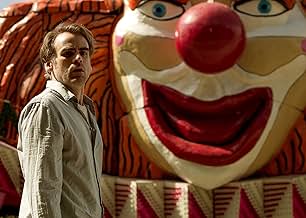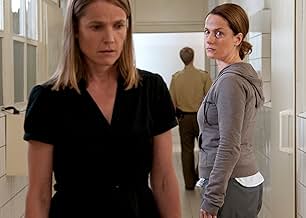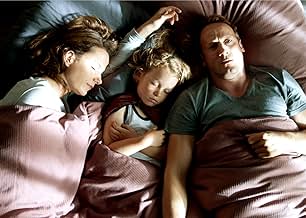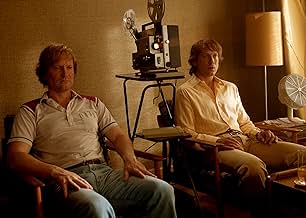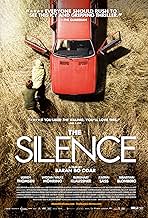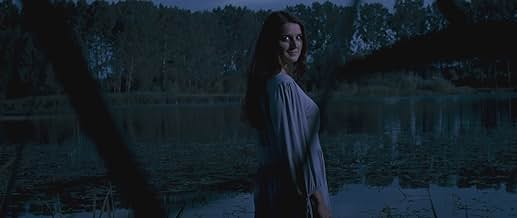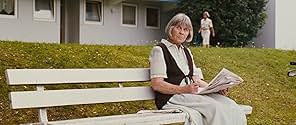CALIFICACIÓN DE IMDb
6.9/10
8.7 k
TU CALIFICACIÓN
Sinikka, de 13 años, desaparece en una calurosa noche de verano. Su bicicleta se encuentra en el lugar exacto donde mataron a una niña hace 23 años. El presente dramático obliga a los involu... Leer todoSinikka, de 13 años, desaparece en una calurosa noche de verano. Su bicicleta se encuentra en el lugar exacto donde mataron a una niña hace 23 años. El presente dramático obliga a los involucrados en el caso original a enfrentar su pasado.Sinikka, de 13 años, desaparece en una calurosa noche de verano. Su bicicleta se encuentra en el lugar exacto donde mataron a una niña hace 23 años. El presente dramático obliga a los involucrados en el caso original a enfrentar su pasado.
- Dirección
- Guionistas
- Elenco
- Premios
- 1 premio ganado y 4 nominaciones en total
Amon Wendel
- Malte
- (as Amon Robert Wendel)
Lena Klenke
- Sinikka
- (as Anna-Lena Klenke)
Helene Luise Doppler
- Pia
- (as Helene Doppler)
- Director
- Guionistas
- Todo el elenco y el equipo
- Producción, taquilla y más en IMDbPro
Opiniones destacadas
"Das Letzte Schweigen" a.k.a. "The Silence" is a sleeper thriller that genuinely shocked and dumbfounded me, but mainly AFTER it was finished! It's the type of film that slowly gets under your skin and the true horror of the plot only hits you afterwards, because you are subconsciously analyzing and re-processing the agitating events over and over again. It was quite a harsh confrontation for me, especially because I'm into dark and devastating horror & cult cinema for nearly two decades now and I have seen numerous of allegedly controversial movies. But "The Silence" is largely different to anything I have ever seen before. It's an extremely slow and moody tale full of totally messed up characters (not a single one qualifies as even remotely normal) and horrifying events & themes that are depicted in a nihilistic and almost everyday fashion. The plot gradually unfolds and the viewer absorbs everything that is coming at him/her, but the truly evil nature of the denouement and the injustice of the climax only hit you – and quite hard, I may add - once the end credits are rolling over the screen. The story starts in a remote little German town in the summer of 1986. Two young men, who share the disgusting passion of watching child pornography (it's not explicitly shown but clearly suggested), are driving around in their red Volkswagen when they spot an 11-year-old girl bike-riding on a dirt road. One of them, Peer Sommer, viciously rapes and murders the defenselessly screaming girl while his pal Timo remains motionless and petrified in the car. Shortly after the incident, Timo flees away from Peer in an attempt to forget everything that has happened and start a new life elsewhere. 23 years later, on the exact same day and on the exact same place, the bicycle and a couple of blood stains of 13-year-old Sinikka Weghamm are discovered. The disappearance of the girl is a nightmare for her parents, but also for the mother of the still unsolved previous murder case as well as for the police officers – retired and incompetent new ones – that are charged with the case. Is it the work of a copycat killer or has the original killer returned? The truth is even more nightmarish than anything you can think of. "The Silence" benefices from a continuously foreboding atmosphere and the gradually revealed details of the case make you uncomfortable. At several points during the movie, you'll find yourself cursing and screaming at the screen in an attempt to speed up the slow police investigation. Themes like child murder and pedophilia automatically make any thriller disturbing, but the sober tone and bleak characters in "The Silence" are almost unbearable. Young director Baran Bo Odar maintains the nail-biting ambiance throughout the entire film and all the acting performances, particularly those of Ulrich Thomsen and Wotan Wilke Möhring, are deeply impressive. There are definitely some plot holes to detect regarding the police investigation and the involvement of the media, but somehow it feels like a factual murder case really could be as ineptly led as this one. The total absence of music, humor and certain background explanations only make the film more haunting. This definitely isn't viewing material for everyone, but highly recommended to thriller fanatics in search of a mature and complex story.
Most murders are committed by people who know their victim, a fact that is standard fare in most whodunits. Rarely are murders committed at random, although the recent horrific thriller Funny Games (1997, remade 2007) presents the worst possible scenario.
But random murders do occur in real life: all over the world, people disappear and forever remain 'dead' with family and friends who are forever in limbo, unable to achieve closure. Only sometimes are the perpetrators caught.
With that thematic background, The Silence presents just that scenario with the rape and murder of a young female teen that remains on the books of the local police for 23 years – until it happens again to another teen, on the same day of the year, at the same place, and with the same modus operandi.
Unlike other serial killer movies – for example, The Silence of the Lambs (1991) – we know the identity of the killer from the get-go. Moreover, we also immediately know there are two perpetrators, although one of them is obviously reluctant to participate, even passively as he watches. As the two criminals, Ulrich Thomsen (as Peer Sommer) and Woltan Mohring (as Timo Friedrich) give strong and believable performances that center upon their individual but similar proclivities for depravity: brave actors both to take on such abhorrent roles.
But why a gap of 23 years? Well, that's where the story really starts, after we see the first murder in the first five minutes. And when the second murder occurs, so also occurs the retirement party for the local police detective (Krischan Mittich played by Burghart Klaussner) who failed to solve the first; so also the return to duty of an eccentric, grieving, widowed officer (David Jahn played by Sebastian Blomberg) who is obviously still distraught by the loss of his wife (to cancer) and who engages in bizarre activity; and so also the emotional awakening of the mother of the first murdered teen (Elena Lange played by Katrin Sass), who has been locked in unrelenting grief for over twenty years.
And in that mix there is repressed and introverted Timo – now a successful architect, beautiful home, lovely wife, two munchkins, the works – who, when he reads about the second murder, knows immediately who it is and decides something must be done But, what?
As the police investigate, and as the clues are revealed, the net – so to speak – tightens without the two miscreants knowing. But, as viewers, we know it all, and gradually we move to the edge of our seat as we see how the wrong decisions are made, how the wrong inferences are drawn, how actions by one can be misconstrued by another all too easily, and ultimately how facts can be ignored or discarded for political expediency or professional jealousy and for the need to close a case, once and for all.
Arguably, suspenseful story doesn't get much better than this; although some viewers might argue about narrative holes and coincidence. However, because it's so believable it's so much better, especially the ending which I'm sure many – maybe most – viewers will not see coming, including me. Only in the last thirty seconds, perhaps when the full irony hits you between the eyes.
The setting is semi-rural, ordinary and faultless; the production is well paced, even at two hours; the dramatic acting – there is absolutely no comic relief – is flawless; and the direction is so good, well, a glance or look truly is more effective than a thousand words. The background music is appropriate but, at times, borders on clichéd, I think. However, this is a movie I'll watch again – not only for the story but also for the narrative structure that combines so many different threads of lives shattered by indifference, inaction, inadequacy or inconsolable sadness.
Highly recommended.
November 2011.
But random murders do occur in real life: all over the world, people disappear and forever remain 'dead' with family and friends who are forever in limbo, unable to achieve closure. Only sometimes are the perpetrators caught.
With that thematic background, The Silence presents just that scenario with the rape and murder of a young female teen that remains on the books of the local police for 23 years – until it happens again to another teen, on the same day of the year, at the same place, and with the same modus operandi.
Unlike other serial killer movies – for example, The Silence of the Lambs (1991) – we know the identity of the killer from the get-go. Moreover, we also immediately know there are two perpetrators, although one of them is obviously reluctant to participate, even passively as he watches. As the two criminals, Ulrich Thomsen (as Peer Sommer) and Woltan Mohring (as Timo Friedrich) give strong and believable performances that center upon their individual but similar proclivities for depravity: brave actors both to take on such abhorrent roles.
But why a gap of 23 years? Well, that's where the story really starts, after we see the first murder in the first five minutes. And when the second murder occurs, so also occurs the retirement party for the local police detective (Krischan Mittich played by Burghart Klaussner) who failed to solve the first; so also the return to duty of an eccentric, grieving, widowed officer (David Jahn played by Sebastian Blomberg) who is obviously still distraught by the loss of his wife (to cancer) and who engages in bizarre activity; and so also the emotional awakening of the mother of the first murdered teen (Elena Lange played by Katrin Sass), who has been locked in unrelenting grief for over twenty years.
And in that mix there is repressed and introverted Timo – now a successful architect, beautiful home, lovely wife, two munchkins, the works – who, when he reads about the second murder, knows immediately who it is and decides something must be done But, what?
As the police investigate, and as the clues are revealed, the net – so to speak – tightens without the two miscreants knowing. But, as viewers, we know it all, and gradually we move to the edge of our seat as we see how the wrong decisions are made, how the wrong inferences are drawn, how actions by one can be misconstrued by another all too easily, and ultimately how facts can be ignored or discarded for political expediency or professional jealousy and for the need to close a case, once and for all.
Arguably, suspenseful story doesn't get much better than this; although some viewers might argue about narrative holes and coincidence. However, because it's so believable it's so much better, especially the ending which I'm sure many – maybe most – viewers will not see coming, including me. Only in the last thirty seconds, perhaps when the full irony hits you between the eyes.
The setting is semi-rural, ordinary and faultless; the production is well paced, even at two hours; the dramatic acting – there is absolutely no comic relief – is flawless; and the direction is so good, well, a glance or look truly is more effective than a thousand words. The background music is appropriate but, at times, borders on clichéd, I think. However, this is a movie I'll watch again – not only for the story but also for the narrative structure that combines so many different threads of lives shattered by indifference, inaction, inadequacy or inconsolable sadness.
Highly recommended.
November 2011.
When the bicycle of a 13-year-old Sinikka is discovered in the exact same wheat field where a heinous murder/rape took place 23 years prior, retired police detective Krischan senses that the two crimes are connected, and vows to bring the killer to justice. The fact that Krischan was unable to catch the killer two decades prior still haunts him to this very day, but perhaps with the help of ambitious young officer David, this time he will find a way to bring closure to the case. Later, as the investigation begins and a sweltering summer heat wave washes over the town, the young victim's parents begin to experience an overwhelming sense of dread concerning a clean cut husband and father who had recently visited their home.
This slow-paced thriller is stunning by all means. The characterization is very well done and cinematography is amazing showing the semi-rural countryside of Germany, the camera angles are fantastic explaining many things about the characters.
The narration is amazing because it has so many ends to tie and agony of the characters has been portrayed impeccably. The direction is watertight; everything is well placed and told significantly.
An original thriller from Swiss born Baran bo Odar, kudos to him.
Recommended to quality cinema lovers.
8/10
This slow-paced thriller is stunning by all means. The characterization is very well done and cinematography is amazing showing the semi-rural countryside of Germany, the camera angles are fantastic explaining many things about the characters.
The narration is amazing because it has so many ends to tie and agony of the characters has been portrayed impeccably. The direction is watertight; everything is well placed and told significantly.
An original thriller from Swiss born Baran bo Odar, kudos to him.
Recommended to quality cinema lovers.
8/10
Baran bo Odar's film begins almost wordlessly on a sunny day in 1986. Two men driving along in a red car (Ulrich Thomsen, Wotan Wilke Möhring) encounter a young girl riding a bicycle (Helene Doppler). They pursue her into a cornfield where one of the men rapes her, kills her with a blow to the head and dumps her corpse in an adjacent lake.
Fast forward to 2009, and one of the two men (Möhring) has become a successful architect, married with two children, while the other (Thomsen) works full-time as a caretaker. The memory of that traumatic occasion haunts both of them, creating a complicated web of lies, deceit and implication that leads to the murder of another young girl (Anna-Lena Klenke).
The film's title not only refers to the silence practiced by the perpetrators of the original crime in 1986, but also describes other people's state of mind. For twenty-three years the murdered girl's mother (Katrin Sass) has kept silent about her harrowing ordeal; likewise the police inspector (Burghart Klaussner) who was involved in the original investigation but failed to achieve a result. It is only after this lengthy time-lapse that they decide to come out and voice their feelings, as well as trying to reconcile themselves to what happened in the past.
Shot in garishly bright colors (by Nikolaus Summerer) creating a world of apparently endless summer weather that nonetheless appears highly dystopian, THE SILENCE offers an insight into the pedophile mind, which often thinks it is doing nothing wrong, even while taking a perverted pleasure in watching child porn videos. The film also takes a look at the ways in which such people are allowed to flourish in societies that prefer to turn their collective backs on such unpleasant issues in the belief that everyone is fundamentally well-intentioned. bo Odar's film proves precisely the opposite; it is often the outwardly most respectable people that prove the most dangerous.
Fast forward to 2009, and one of the two men (Möhring) has become a successful architect, married with two children, while the other (Thomsen) works full-time as a caretaker. The memory of that traumatic occasion haunts both of them, creating a complicated web of lies, deceit and implication that leads to the murder of another young girl (Anna-Lena Klenke).
The film's title not only refers to the silence practiced by the perpetrators of the original crime in 1986, but also describes other people's state of mind. For twenty-three years the murdered girl's mother (Katrin Sass) has kept silent about her harrowing ordeal; likewise the police inspector (Burghart Klaussner) who was involved in the original investigation but failed to achieve a result. It is only after this lengthy time-lapse that they decide to come out and voice their feelings, as well as trying to reconcile themselves to what happened in the past.
Shot in garishly bright colors (by Nikolaus Summerer) creating a world of apparently endless summer weather that nonetheless appears highly dystopian, THE SILENCE offers an insight into the pedophile mind, which often thinks it is doing nothing wrong, even while taking a perverted pleasure in watching child porn videos. The film also takes a look at the ways in which such people are allowed to flourish in societies that prefer to turn their collective backs on such unpleasant issues in the belief that everyone is fundamentally well-intentioned. bo Odar's film proves precisely the opposite; it is often the outwardly most respectable people that prove the most dangerous.
Suspense fans tired of low-brow, explicit exploitation movies may want to check out "The Silence," an absorbing German thriller that delivers the suspense without sacrificing the drama. At a confident and steady pace, the script allows the characters to develop powerful, yet subtle performances.
On July 8th, 1986, a eleven year old girl Pia (Helene Doppler) is raped and murdered by Peer (Ulrich Thomsen) while a second man, Timo (Wotan Wilke Möhring), watches with equal parts of disgust and arousal. The two dispose of the body and return home, but while Peer began to destroy any potential evidence, Timo has already packed and boarded a bus out of town. 23 years later, to the very day, another young girl goes missing with only her bike and bag left behind at the very spot where Pia was abducted years ago. Writer/director Baran bo Odar's film, "The Silence," follows the distraught families, the police, and the two men behind the original unsolved case in a story that explores grief and guilt, obsession and duty.
It's a well-acted, emotion-charged drama whose murder mystery is almost secondary to the human element. It's a complex examination of the many facets of humanity in which even those who commit the most heinous acts aren't complete monsters. The film is about tragedy and the everlasting impact on those involved, from the victims to the perpetrators.
Director Baran bo Odar maintains a sense of morbid fascination in a film that in someone else's hands might become overwhelmingly unpleasant. Despite its nearly two-hour running time, it never becomes dull or depressing, thanks in part to large cast of characters whose nuanced portrayals strike a chord of truth -- terrifyingly so for any parent. Even though the conclusion isn't exactly overpowering, the journey is remarkably nuanced and compelling – and most certainly an uncomfortable one.
On July 8th, 1986, a eleven year old girl Pia (Helene Doppler) is raped and murdered by Peer (Ulrich Thomsen) while a second man, Timo (Wotan Wilke Möhring), watches with equal parts of disgust and arousal. The two dispose of the body and return home, but while Peer began to destroy any potential evidence, Timo has already packed and boarded a bus out of town. 23 years later, to the very day, another young girl goes missing with only her bike and bag left behind at the very spot where Pia was abducted years ago. Writer/director Baran bo Odar's film, "The Silence," follows the distraught families, the police, and the two men behind the original unsolved case in a story that explores grief and guilt, obsession and duty.
It's a well-acted, emotion-charged drama whose murder mystery is almost secondary to the human element. It's a complex examination of the many facets of humanity in which even those who commit the most heinous acts aren't complete monsters. The film is about tragedy and the everlasting impact on those involved, from the victims to the perpetrators.
Director Baran bo Odar maintains a sense of morbid fascination in a film that in someone else's hands might become overwhelmingly unpleasant. Despite its nearly two-hour running time, it never becomes dull or depressing, thanks in part to large cast of characters whose nuanced portrayals strike a chord of truth -- terrifyingly so for any parent. Even though the conclusion isn't exactly overpowering, the journey is remarkably nuanced and compelling – and most certainly an uncomfortable one.
¿Sabías que…?
- TriviaDirector Baran bo Odar has said that South Korean movie Salinui chueok (2003) was a big inspiration for this movie.
- ErroresAt the start of the TV interview the clock in the control room counts up to 21:40:11 until a cut. Several short scenes later the same clock is shown, again counting up to 21:40:11.
- Bandas sonorasPia
written & produced by Michael Kamm, Kris Steininger (as Pas de Deux)
Selecciones populares
Inicia sesión para calificar y agrega a la lista de videos para obtener recomendaciones personalizadas
- How long is The Silence?Con tecnología de Alexa
Detalles
Taquilla
- Presupuesto
- EUR 2,300,000 (estimado)
- Total en EE. UU. y Canadá
- USD 100,214
- Fin de semana de estreno en EE. UU. y Canadá
- USD 7,992
- 10 mar 2013
- Total a nivel mundial
- USD 416,675
- Tiempo de ejecución1 hora 58 minutos
- Color
- Mezcla de sonido
- Relación de aspecto
- 2.35 : 1
Contribuir a esta página
Sugiere una edición o agrega el contenido que falta

Principales brechas de datos
What is the French language plot outline for Das letzte Schweigen (2010)?
Responda

